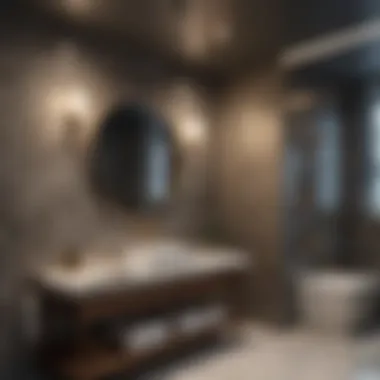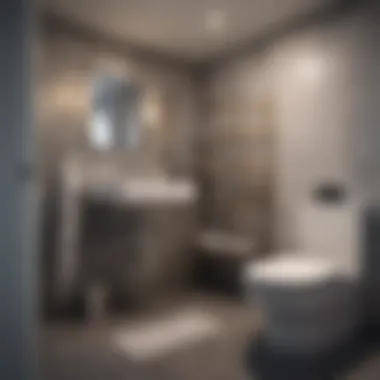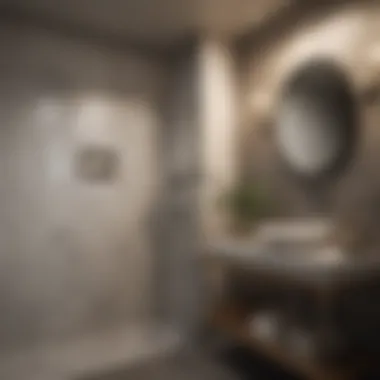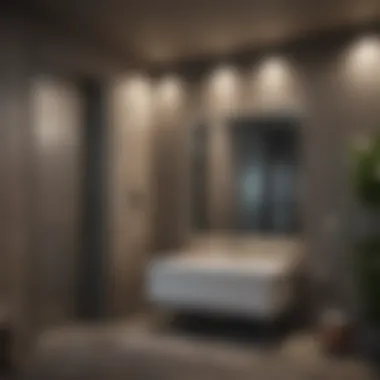Understanding Basement Bathroom Addition Costs


Intro
Adding a bathroom in your basement can significantly enhance the functionality and value of your home. Many homeowners find themselves contemplating this project, often motivated by the necessity for extra space or the desire to increase property worth. but understanding the costs involved is crucial for making informed decisions. This article strives to explore the detailed aspects of adding a bathroom to your basement, analyzing key factors such as design choices, materials, labor costs, and local regulations.
When planning such a renovation, it is important to consider the various styles and themes that can influence your choices. As you will see, every detail counts. From trending styles to color palettes, each aspect can affect both the aesthetic appeal and the overall cost of the project. The following sections aim to equip you with essential knowledge and insights, ensuring that your investment not only meets your needs but also takes advantage of current trends.
Let’s commence with an examination of popular trends in basement bathroom design.
Overview of Basement Bathroom Additions
Adding a bathroom in the basement is a significant home improvement project. This section provides crucial insights into the rationale behind basement bathroom additions. Understanding the scope and benefits is essential for homeowners contemplating this renovation. A basement bathroom can offer increased convenience and utility, transforming an often underutilized space into a functional area.
Prolusion to Basement Bathrooms
Basement bathrooms serve various purposes. They can be a full bathroom, offering a shower, toilet, and sink, or a simple powder room with just a toilet and sink. The choice of layout often depends on available space and intended usage. Integrating a bathroom into a basement can optimize the overall functionality of a home. Homeowners can find value in the comfort and convenience that a well-designed basement bathroom provides.
Reasons for Adding a Bathroom
Increasing home value
Adding a bathroom in the basement can significantly increase home value. This improvement appeals to potential buyers who look for functional living spaces. Real estate professionals often suggest that homes with multiple bathrooms command higher prices in the market. An extra bathroom can make your house more attractive, especially in neighborhoods where properties typically feature more bedrooms than bathrooms. Whether it's a family looking for space or an investor aiming for returns, a basement bathroom can be an advantageous investment.
Enhancing functionality
Enhancing functionality is another reason homeowners consider adding a bathroom. A basement without a bathroom may limit its usability. Families with teenagers or guests may find it inconvenient if they need to use upper floor bathrooms. A basement bathroom can provide privacy and ease of access. Additionally, it can facilitate laundry use, entertaining guests, or creating a private space for relaxation. Thus, a functional basement bathroom is not just an improvement—it becomes necessary for many.
Accommodating guests
Accommodating guests is a practical reason for adding a bathroom in the basement. For homes that frequently host visitors, having an extra bathroom can enhance their stay. Guests value the ability to maintain privacy during their visit. A basement bathroom can serve this need effectively. Moreover, it helps reduce traffic and waiting times for others in the household. When entertaining, such facilities add comfort for all parties involved.
A well-designed basement bathroom can significantly improve your home's comfort and resale value.
In summary, the decision to add a bathroom in your basement is supported by various factors. From increasing home value to enhancing daily functionality, it presents multiple rewards for homeowners. Understanding these elements sets the groundwork for making an informed choice regarding basement renovations.
Cost Breakdown: Factors Influencing the Price
Understanding the cost breakdown for adding a bathroom in your basement is critical for homeowners. This section provides clarity on various elements that impact the overall expense of this construction project. It addresses how different factors contribute to the total budget and why awareness of these contributions is beneficial before embarking on such an endeavor.
Design and Layout Considerations
Design choices markedly affect the cost and efficacy of basement bathroom additions. The goal is not merely to place fixtures in a space but to create an environment that serves its intended purpose efficiently and attractively.
Type of bathroom
The type of bathroom, whether it is a full bath, half bath, or powder room, drives the scope and complexity of the project. A full bath includes a shower or tub, toilet, and sink. This necessitates a more substantial plumbing installation and likely requires more space, thus increasing cost. A half bath may suffice for limited facilities, allowing for lower expenses while still improving functionality. This choice can provide significant benefits with a smaller investment, making it a popular option among homeowners looking to maximize space without overstretching their budget.
Space optimization
Space optimization revolves around effectively utilizing the often limited room available in a basement. Thoughtful design can enhance the accessibility and comfort of the area. Consider corners, alcoves, and vertical space to improve usability without extensive remodeling. The characteristic of optimizing space ensures that even small bathrooms can be quite functional, which ultimately saves costs associated with extensive renovations. Balancing functionality with design can lead to unique features like floating vanities that create a sense of openness, although they may come with a higher price tag.
Material Choices
Choosing the right materials is integral in influencing the overall cost of a basement bathroom addition. Selecting appropriate fixtures and finishes provides homeowners with options that fit budgets and aesthetics.
Fixtures and fittings
Fixtures and fittings can vary greatly in price depending on design and quality. High-end brands offer luxurious options, while budget-friendly brands present viable alternatives. Quality fixtures enhance the bathroom's longevity and aesthetics, thus justifying a potentially higher initial cost. However, going with lower-quality fittings can lead to frequent replacements or repairs, which may cost more overtime.


Flooring and wall materials
Flooring and wall materials also have a substantial impact on the overall expenses. Waterproof options are essential in basements, and while materials like tiles and vinyl can provide durability, they also range significantly in price. The unique feature of choosing the right wall materials adds both insulation and comfort to the setting, which can enhance energy efficiency. Balancing durability and cost-effectiveness when selecting these materials will play a key role in the project's success.
Labor Costs
Labor costs are a major portion of any renovation project. An understanding of the labor aspect allows homeowners to budget more effectively.
Contractor fees
Contractor fees usually represent a significant part of the overall cost. This includes planning, scheduling, and executing the renovations. Hiring a professional contractor can save time and stress, ensuring the work meets local regulations and standards. Yet, it comes at a price. It's crucial to gather multiple estimates and verify credentials to ensure you are getting a fair rate. A contractor might also offer warranties or guarantees that can save money in future repairs.
DIY versus hiring professionals
Considering whether to tackle the project independently or hire professionals is essential. DIY can lead to substantial savings on labor, but it often comes with its own set of challenges. Assessing personal skill levels and the scope of the project is crucial. Some may find that hiring professionals ensures a quality finish that DIY efforts can't match, thus protecting long-term investments. While DIY may feel appealing, it may require more time and lead to unexpected costs if mistakes occur.
Permits and Regulations
Compliance with local regulations is necessary when planning a bathroom addition. This requires understanding the associated permits and building codes.
Local building codes
Local building codes specify the standards for construction and safety for bathroom additions. Understanding these codes is important to avoid fines or work stoppages. Not adhering can lead to further renovations down the road, creating additional costs. Engaging a contractor familiar with the regulations in your area will simplify the process and ensure compliance.
Cost of permits
The cost of permits varies by locality and can add another layer of expenses. Typically, homeowners must budget for these costs as part of their overall construction budget. It’s essential to check with local authorities about the required permits and their costs. A well-planned budget accounts for these expenses upfront, preventing any unexpected added costs that can arise from negligence.
To summarize, understanding these factors can lead to more informed decisions and better financial planning for your basement bathroom project.
Average Costs for Basement Bathroom Additions
Understanding the average costs for adding a bathroom in your basement is essential for homeowners considering this renovation. This topic encompasses various elements that directly impact the financial investment required for such an addition. From material choices to labor costs, the importance of knowing these costs cannot be overstated. By gaining insight into what to expect, homeowners can make informed decisions that enhance the value of their property while meeting their family's needs. Key considerations include regional price variations, typical expense ranges, and understanding different installation levels.
Cost Estimates by Region
The costs associated with adding a basement bathroom can fluctuate significantly based on geographical location. For instance, in areas like New York or California, labor and material costs tend to be higher compared to regions in the Midwest or Southern states. Local demand for construction services, the cost of living, and even local building codes can contribute to these differences. This regional variance means that homeowners should research their specific area, as understanding these cost estimates will inform budgeting and planning efforts.
Typical Expense Ranges
The typical expense ranges for adding a bathroom in a basement generally fall into three categories: low-end installations, mid-range considerations, and high-end custom designs. Each of these categories addresses distinct needs and budgets and offers different levels of quality and design.
Low-end installations
Low-end installations often include basic fixtures and minimal design. This cost-effective approach focuses on essentials, providing functional space without unnecessary frills. A typical low-end bathroom might feature standard materials and simple plumbing layouts that adhere to basic requirements. The advantage here is affordability, making it a popular choice for homeowners on a tight budget. However, these installations may lack the aesthetic appeal or advanced features that more expensive options provide.
Mid-range considerations
Mid-range considerations offer a balance between cost and quality. Homeowners opting for this category often choose upgraded materials and a more thoughtful design layout. This mid-range approach generally includes better fixtures, enhanced flooring materials, and possibly some customization in the layout. While more costly than low-end options, the benefits include improved aesthetics and durability. It serves as a viable option for many homeowners who want to enhance their bathroom without going overboard on their budget.
High-end custom designs
High-end custom designs represent the pinnacle of basement bathroom installations. These projects focus on personalized designs, luxurious materials, and superior craftsmanship. Homeowners choosing this category might include features such as high-end plumbing fixtures, custom cabinets, and unique lighting solutions. These installations, while significantly higher in cost, can considerably increase property value and provide a bespoke environment tailored to personal tastes and preferences. However, homeowners must consider potential return on investment in line with their long-term goals.
"Investing in a basement bathroom can significantly affect both the comfort of your home and its market value."
Each of these expense ranges offers distinct benefits and characteristics. Homeowners should assess their priorities and budgets carefully before making a decision.


Alternative Solutions and Configurations
Exploring alternative solutions and configurations for basement bathrooms is vital for homeowners to maximize both functionality and cost-efficiency. The flexibility in design can lead to a space that meets individual needs without extensive financial expenditure. Understanding different approaches allows homeowners to tailor their projects. This section discusses two primary routes: partial bathroom installations and upgrading existing basements, including their respective pros and cons.
Partial Bathroom Installations
Half baths
Half baths, commonly consisting of a toilet and sink, provide a viable option for those looking to add a bathroom without committing to full renovations. The simplicity of a half bath makes it a popular choice. They require less space and lower costs than full bathrooms, thus appealing to homeowners on a budget. One unique aspect of half baths is their ease of installation, particularly in basements with limited plumbing infrastructure.
However, while they enhance convenience for guests and residents alike, half baths may not add the same value as a full bathroom in terms of property appreciation. This can be a significant consideration for homeowners who plan to sell in the future. All in all, the option remains beneficial for those who need basic functionality without extensive investment.
Powder rooms
Similar to half baths, powder rooms are another valuable addition that often includes a sink and toilet. Unlike half baths, powder rooms can feature more stylish fixtures and aesthetic upgrades, allowing for personalized touches. They are especially beneficial for high-traffic areas within the basement.
What sets powder rooms apart is their design potential; many homeowners incorporate stylish elements such as wallpaper or lighting fixtures, enhancing the aesthetic appeal. Thus, while they may demand a slightly higher budget than half baths, the ability to transform a small space into a visually appealing area can yield greater long-term satisfaction.
Nevertheless, the limited plumbing and space may restrict the installation of extra features, which could be a drawback for some.
Upgrading Existing Basements
Adding plumbing
Adding plumbing into an existing basement can significantly enhance the overall plumbing system. This can bring forth the possibility of creating a bathroom or updating current plumbing for better flow and efficiency. Importantly, adding plumbing is a crucial part of many basement developments aimed at accommodating an additional bathroom.
The primary advantage lies in increased functionality; it allows for a range of appliances and fixtures that would otherwise be impossible. An effective plumbing upgrade can yield practical benefits and potentially increase the home’s market value. That said, the labor costs associated with plumbing installation should not be overlooked, as they can be a notable expense in the overall budget.
Improving ventilation
Improving ventilation in a basement is crucial for both comfort and air quality. Proper ventilation prevents moisture buildup, which can lead to mold and mildew - common problems in basement settings. An upgrade in ventilation offers a safer environment, especially when adding new fixtures such as sinks or bathtubs.
Moreover, improved airflow can create a more inviting atmosphere, beneficial for anyone spending time in the basement. It is often seen as a proactive step in any renovation project, as maintaining air quality is essential in residential spaces. However, the installation of ventilation systems can come with its own costs, which need to be factored into any budget discussions.
"Understanding the various configurations for adding bathrooms can drastically impact the overall cost and future usability of the basement space."
As homeowners weigh these options, they should consider both their current needs and future goals. Balancing cost with utility will help in making sound decisions that enhance the home's value.
Financing Your Basement Bathroom Project
Financing a basement bathroom project is crucial for homeowners who want to maximize their investment while managing costs effectively. Many people may underestimate or overlook the financial aspect of this project. However, understanding how to budget and identify suitable financing options can significantly influence the overall success of the renovation. Proper financing ensures that homeowners can afford the necessary renovations without overextending themselves financially. Furthermore, awareness of different funding methods helps in making informed decisions that align with personal financial goals.
Budget Planning and Allocation
Creating a detailed budget is the first step for homeowners before embarking on a basement bathroom project. It is important to allocate funds not only for materials but also for labor, permits, and unexpected expenses. Here are some key points to consider for effective budget planning:
- Assess the total cost: Get a rough idea of the costs involved by researching regional averages and obtaining quotes.
- Prioritize needs versus wants: Identify essential requirements and distinguish them from less critical upgrades. This helps to set limits on spending towards luxury items.
- Include a contingency fund: Setting aside an additional 10-20% of your total budget can protect against unforeseen costs that may arise during renovation.
By carefully planning and sticking to a budget, homeowners can navigate through the renovation process with financial confidence.
Loan and Financing Options
Choosing the right loan or financing option is essential for affording a basement bathroom. Different methods offer various advantages depending on the homeowner’s unique circumstances.
Home equity loans
Home equity loans are a popular choice for funding home renovations. This option allows homeowners to borrow against the equity they have built up in their homes. The primary characteristic of home equity loans is that they typically offer lower interest rates compared to other types of loans.


- Benefits: Home equity loans often provide a lump sum that can be used directly for renovations. Since the loan is secured by the home, lenders may offer better terms.
- Considerations: However, this type of financing can be risky. If a homeowner cannot repay the loan, it may lead to foreclosure. Thus, careful consideration of repayment plans is vital.
Overall, home equity loans are a beneficial option for homeowners looking to add significant value to their properties while managing costs effectively.
Construction loans
Construction loans serve as short-term financing designed specifically for home building or renovation projects. This type of loan covers the costs while construction is ongoing and is often converted into a mortgage once the project is completed. One of its key features is that it disburses funds at various stages of construction based on completed milestones.
- Advantages: Construction loans provide flexibility as they can cover various associated costs like materials and labor. Homeowners only pay interest during construction, usually leading to lower initial payments.
- Disadvantages: On the downside, construction loans may have higher interest rates and require detailed project plans to secure approval, which could delay the funding process.
Choosing the right financing option can significantly affect the feasibility and success of adding a bathroom in the basement. Understanding budget allocation, as well as the various loans available, empowers homeowners to make informed decisions that align with their financial situation.
Future Considerations for Homeowners
Adding a bathroom in your basement comes with various considerations that extend beyond the immediate costs. Homeowners should think about long-term implications, especially related to property value and how the space can be utilized in the future. In this section, we will discuss some critical factors to consider when planning your basement bathroom project.
Value Appreciation
When homeowners invest in adding a bathroom, they often seek a return on that investment through increased property value. A basement bathroom can significantly enhance a home's market appeal. Many potential buyers see extra bathrooms as a selling point, which can elevate the overall value of the home. Real estate experts frequently discuss how having more bathrooms often correlates to higher sale prices. Therefore, this addition is not merely an expense but can act as a prudent financial decision.
Moreover, a well-planned bathroom can contribute to a more functional living space. For example, converting an unused area into a valuable bathroom can increase the square footage's usability. This functional enhancement can attract buyers who appreciate additional amenities.
"Homebuyers are increasingly looking for properties that offer adequate facilities, and an extra bathroom is among their top priorities."
Trends in Basement Utilization
Basements are evolving from simple storage spaces to multifunctional areas. This shift includes using basements for leisure, guest accommodations, or additional living space. Therefore, when adding a bathroom, it can be beneficial to consider how this space fits into broader trends in home utilization.
Modern Amenities
Incorporating modern amenities into a basement bathroom is crucial for enhancing both comfort and functionality. Homeowners often favor contemporary fixtures, energy-efficient appliances, and user-friendly designs. These elements not only improve the overall aesthetic but can significantly impact the efficiency of the space.
For instance, modern fixtures often come with water-saving technologies, which can reduce utility bills. These advantages highlight why modern amenities are a popular choice for homeowners seeking to maximize their renovations.
However, homeowners must balance trends with costs. While the latest designs are appealing, they can often come with premium pricing. Therefore, careful budgeting and planning are essential.
Sustainability Practices
Sustainability practices have become increasingly popular among homeowners. Incorporating eco-friendly elements into your basement bathroom can enhance its appeal to environmentally-conscious buyers. This might include using sustainable materials, low-flow fixtures, or energy-efficient lighting.
Using recycled materials, for example, might carry initial costs, yet offer long-term savings and a reduced environmental footprint. Thus, sustainability is a beneficial approach to modern home renovations.
Nonetheless, homeowners should also consider the availability of sustainable products in their areas. Not all regions offer the same selection, which could influence decisions and implementation.
The End
Determining the average cost to add a bathroom in your basement is a significant aspect of any home renovation project. This decision can not only enhance the functionality of your living space but also potentially increase the value of your home. Homeowners must consider various factors that influence costs, such as design, materials, labor, and local regulations.
One of the key elements is understanding that investing in a basement bathroom extends beyond immediate expenses. The benefits may include increased home value and improved convenience for family and guests. It supports better utilization of the basement area, transforming it from a simple storage space into a livable environment.
As this article outlines, careful planning is essential. This includes a clear budget, identifying reliable services, and ensuring compliance with local building codes. Such preparation can avoid unforeseen costs and ensure a smoother renovation experience.
Ultimately, each homeowner's situation is unique. Assessing personal needs and financial capacity will dictate the specifics of the project.
"Maximizing the investment in a basement bathroom requires a blend of practical design, quality materials, and skilled labor."
Key Takeaways
- Bathroom additions can significantly boost property value.
- Understanding regional cost variations helps in accurate budgeting.
- Choices in layout, design, and materials play a crucial role in overall costs.
- Future planning for home renovations should consider both current needs and potential increases in home functionality.
- Keeping abreast of local regulations can prevent costly setbacks in your renovation project.
Next Steps for Planning
- Set a Clear Budget: Understand your financial limitations and what you can realistically spend.
- Research: Look into local contractors and suppliers. Read reviews and seek recommendations.
- Consult Professionals: Discuss your ideas with architects or designers to get expert opinions on layout and design.
- Define Your Needs: Assess how you plan to use the space, whether for guests, family, or personal use.
- Plan for Permits: Investigate local building codes and permit requirements early on.
- Develop a Timeline: Outline your project's expected timeline, considering potential delays that can arise during renovations.
Each step is critical toward making informed decisions about adding a bathroom in your basement.















